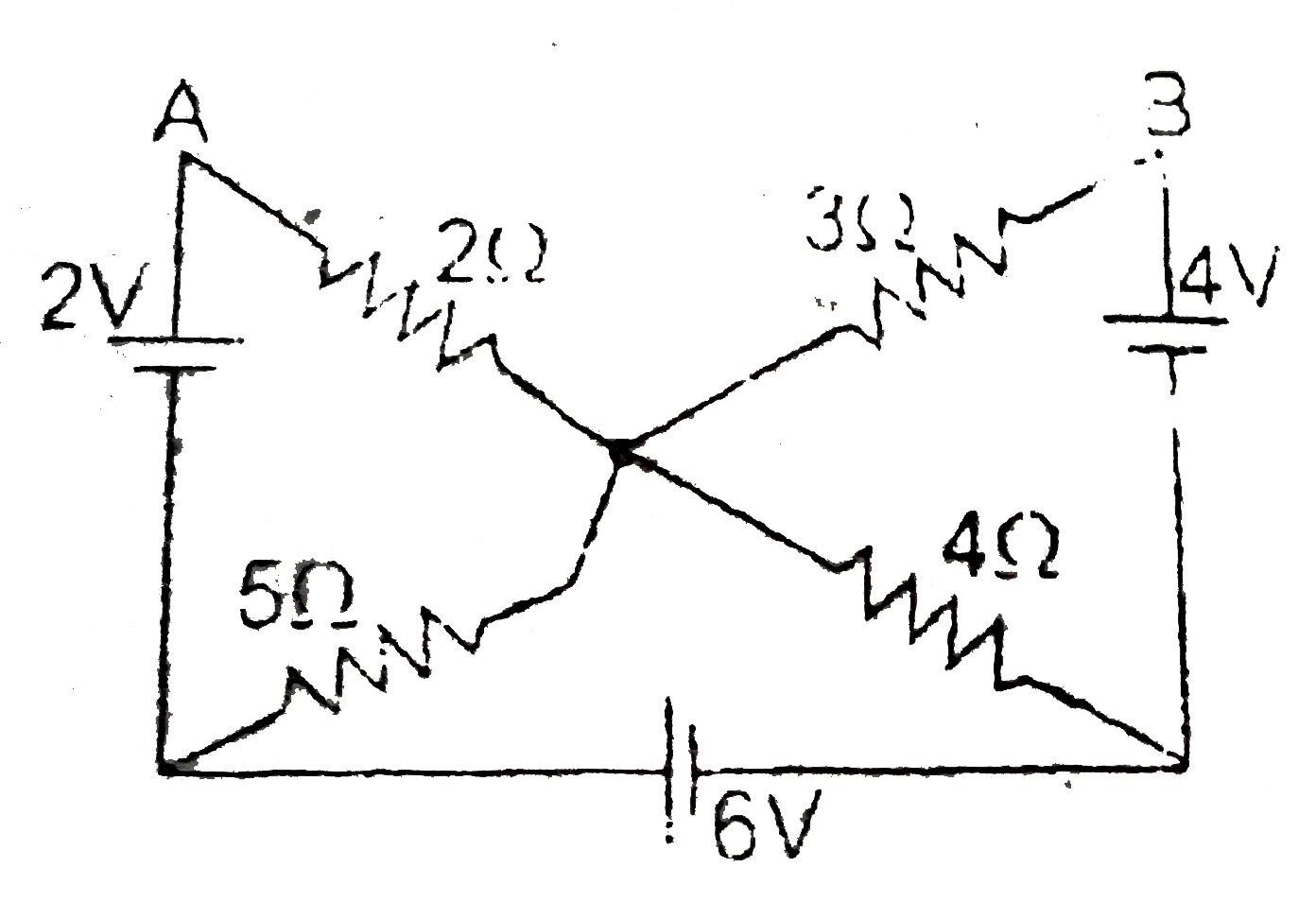Potential difference between two points (VA−VB) in an electric field E=(2ˆi−4ˆj)N/C, where A=(0,0) and B=(3m,4m) is
10V
−10V
16V
−16V
The correct Answer is:B
To find the potential difference between two points A and B in an electric field, we can use the formula:
VA−VB=−∫BAE⋅dr
Step 1: Define the Electric Field and Points
Given:
- Electric field E=2^i−4^jN/C
- Point A=(0,0)
- Point B=(3m,4m)
Step 2: Set Up the Differential Displacement Vector
The differential displacement vector dr can be expressed as:
dr=dx^i+dy^j
Step 3: Substitute into the Integral
Now we substitute E and dr into the integral:
VA−VB=−∫BA(2^i−4^j)⋅(dx^i+dy^j)
Step 4: Calculate the Dot Product
Calculating the dot product:
E⋅dr=(2^i−4^j)⋅(dx^i+dy^j)=2dx−4dy
Step 5: Set Up the Integral
Now we can set up the integral:
VA−VB=−∫BA(2dx−4dy)
Step 6: Determine the Limits of Integration
For the path from point A(0,0) to point B(3,4), we can integrate x from 0 to 3 and y from 0 to 4.
Step 7: Evaluate the Integral
Now we can evaluate the integral:
VA−VB=−(∫302dx+∫40(−4)dy)
Calculating each integral:
1. ∫302dx=2x∣∣30=2(3)−2(0)=6
2. ∫40−4dy=−4y∣∣40=−4(4)−(−4)(0)=−16
Step 8: Combine the Results
Substituting back into the equation:
VA−VB=−(6−16)=−(−10)=10
Final Result
Thus, the potential difference VA−VB is:
VA−VB=−10V
Given:
- Electric field E=2^i−4^jN/C
- Point A=(0,0)
- Point B=(3m,4m)
The differential displacement vector dr can be expressed as:
dr=dx^i+dy^j
Now we substitute E and dr into the integral:
VA−VB=−∫BA(2^i−4^j)⋅(dx^i+dy^j)
Calculating the dot product:
E⋅dr=(2^i−4^j)⋅(dx^i+dy^j)=2dx−4dy
Now we can set up the integral:
VA−VB=−∫BA(2dx−4dy)
For the path from point A(0,0) to point B(3,4), we can integrate x from 0 to 3 and y from 0 to 4.
Now we can evaluate the integral:
VA−VB=−(∫302dx+∫40(−4)dy)
1. ∫302dx=2x∣∣30=2(3)−2(0)=6
2. ∫40−4dy=−4y∣∣40=−4(4)−(−4)(0)=−16
Substituting back into the equation:
VA−VB=−(6−16)=−(−10)=10
Thus, the potential difference VA−VB is:
VA−VB=−10V
Topper's Solved these Questions
- ELECTROSTATIC POTENTIAL AND CAPACITORSBOOK - DC PANDEY ENGLISHCHAPTER - ELECTROSTATIC POTENTIAL AND CAPACITORSEXERCISE - (B) Chapter exercises
17 Videos
- ELECTROSTATIC POTENTIAL AND CAPACITORSBOOK - DC PANDEY ENGLISHCHAPTER - ELECTROSTATIC POTENTIAL AND CAPACITORSEXERCISE - (C) Chapter exercises
50 Videos
- ELECTROSTATIC POTENTIAL AND CAPACITORSBOOK - DC PANDEY ENGLISHCHAPTER - ELECTROSTATIC POTENTIAL AND CAPACITORSEXERCISE - Check point 2.5
20 Videos
- ELECTROMAGNETIC WAVESBOOK - DC PANDEY ENGLISHCHAPTER - ELECTROMAGNETIC WAVESEXERCISE - Sec C
22 Videos
- ELECTROSTATICSBOOK - DC PANDEY ENGLISHCHAPTER - ELECTROSTATICSEXERCISE - Medical entrances gallery
37 Videos
Similar Questions
Knowledge Check
The potential field of an electric field →E=(yˆi+xˆj) is
AV = -(x+y) + constantBV = constantCV=−(x2+y2)+ constantDV = -xy + constant
Find the potential V of an electrostatic field →E=a(yˆi+xˆj), where a is a constant.
View SolutionFind the potential difference VAB between A(0,0,0)andB(1m,1m,1m) in an electric field :
(i) →E=(yˆi+xˆj)Vm−1
(ii) →E=(3x2yˆi+x3ˆj)Vm−1.
View SolutionFind the potential difference VAB between A(2m,1m,0) and B(0,2m,4m) in an electric field,
E=(xˆi−2yˆj+zˆk)Vm
View SolutionAn electric field is expressed as →E=2ˆi+3ˆj. Find the potential difference (VA−VB) between two points A and B whose position vectors are given by rA=ˆi+2ˆjandrB=2ˆi+ˆj+3ˆk.
View SolutionCharge Q is given a displacement →r=aˆi+bˆj in an electric field →E=E1ˆi+E2ˆj. The work done is.
View SolutionFind Vab in an electric fiels →E=(2ˆI+3ˆj+4ˆk)NC−1 where →ra=(ˆI−2ˆj+ˆk)m and →rb=(2ˆi+ˆj−2ˆk)m.
View SolutionThe displacement of a charge Q in the electric field →E=e1ˆi+e2ˆj+e3ˆk is →r=aˆi+bˆj. The work done is
View Solution

